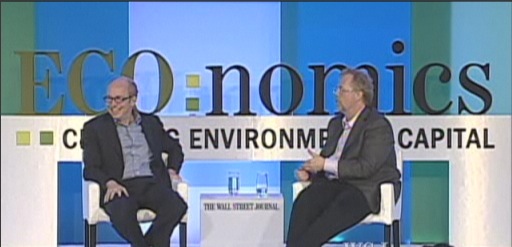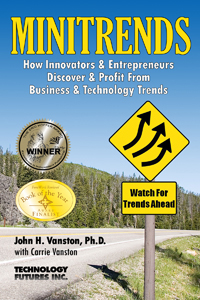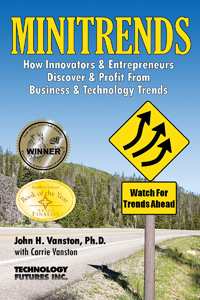MiniTrends 2012: A Conference on Translating Emerging Trends into Business Opportunities
August 13, 2012
Discover, Evaluate, Profit! Join us in Downtown Austin on October 17-18, the place Forbes’ calls the “Best Big City for Jobs,” to listen and participate as business leaders and forward thinkers discuss starting new ventures or growing established organizations through attention to MiniTrends—emerging trends that will soon become important, but are not yet widely recognized. Find out what future trends and convergences they see on the horizon and how you can find profitable emerging trends of your own!
Achieving and sustaining success in the current environment of unprecedented marketplace innovation means being constantly alert to new and exciting MiniTrends that provide business and technological opportunities. MiniTrends offer great opportunities to those alert enough to recognize them, perceptive enough to appreciate them, and clever enough to take advantage of them. Austin is a growing entrepreneurial hub that offers a culture built on collaboration, innovation, and creativity. What better place to find out how you, too, can develop a Minitrend Mindset?
You Should Attend if You are:
- An Entrepreneur wishing to identify, assess, and exploit attractive new business opportunities
- A Decision Making Executive, Director, Manager, or Professional in a Small or Mid-Size Business wanting to gain advantage by recognizing and utilizing emerging trends
- An Innovative Thinking Executive, Director, Manager, or Professional in a Larger Business aspiring to distinguish yourself by your special insights and perceptiveness
- An Investor interested in uncovering attractive new investment opportunities
- A Job Seeker wishing to define employment opportunities
What You will Gain:
- A creative mind-set and resources for finding and taking advantage of emerging trends and opportunities relating to your own area of expertise and interest
- A preview of MiniTrends that thought-leaders see developing
- Experience, knowledge, and wisdom from innovative leaders sharing how they use emerging trends to start new ventures or grow established organizations
- Tactics to identify untapped business opportunities from converging trends
- Interaction with speakers and fellow participants to learn, mix, and share ideas
 Strategy and insights to create or grow your organization and, in the process, find your bliss!
Strategy and insights to create or grow your organization and, in the process, find your bliss!- An opportunity to enjoy the Live Music Capital of the World!
- BONUS!! Copy of award-winning book MINITRENDS: How Innovators & Entrepreneurs Discover & Profit From Business & Technology Trends.
Speakers:
 Chair: Dr. John H. Vanston, Chairman, Technology Futures, Inc.
Chair: Dr. John H. Vanston, Chairman, Technology Futures, Inc.
John founded TFI in 1978, building the Austin, Texas-based company into a leading authority in custom research and technology forecasting. His MiniTrends concept, designed to increase creativity, innovation, and success, is summarized in MINITRENDS: How Innovators & Entrepreneurs Discover & Profit From Business & Technology Trends. The book has received several Best Business Book awards and excellent reviews and endorsements.
 Keynote: David Pearce Snyder, Consulting Futurist; Contributing Editor, The Futurist
Keynote: David Pearce Snyder, Consulting Futurist; Contributing Editor, The Futurist
David has been in the forecasting business for over 30 years, during which he has built an impressive track record with a wide range of clientele, while compiling a multi million item data base of trends and projections. David has given thousands of seminars on strategic thinking, edited/co-authored five books, and written hundreds of studies, articles and reports on the impacts of new technologies.
 Michael Bettersworth, Associate Vice Chancellor for Technology Advancement, Texas State Technical College (TSTC)
Michael Bettersworth, Associate Vice Chancellor for Technology Advancement, Texas State Technical College (TSTC)
Michael founded TSTC Forecasting to identify and analyze new technical competencies needed by employers in order to improve student employability through curriculum alignment with market demand. TSTC Forecasting has published many studies on emerging technologies and occupations. New studies are currently underway in big data, unmanned aerial systems, and social media.
 Andy Fish, President, Formula Austin, LLC; President and CEO at LISA – Legislative Information Services of America
Andy Fish, President, Formula Austin, LLC; President and CEO at LISA – Legislative Information Services of America
Andy Fish and Anne Fish started Formula Austin LLC last year to plug visitors into Austin’s culture and business scene in the days before and after the U.S. Formula One Grand Prix, now based in Austin. Formula Austin aims to link visitors up with authentic Austin experiences and has partnered with 42 local businesses, professionals and musicians to offer a large variety of activities.
Dr. August E. (“Augie”) Grant, J. Rion McKissick Professor of Journalism, School of Journalism and Mass Communications, University of South Carolina
Augie is a technology futurist who specializes in research on new media technologies and consumer behavior and market opportunities for emerging technologies. He is Editor of Communication Technology Update and Fundamentals, now in its thirteenth edition, which is used extensively in industry and has become one of the top-selling textbooks in the field of Communication Technology.
 Christopher Justice, Chief Executive Officer at Sparksight, Inc.; Founder, Justice Pest Services
Christopher Justice, Chief Executive Officer at Sparksight, Inc.; Founder, Justice Pest Services
Christopher co-founded Sparksight® in 2006 and has built the company into a well-respected design agency that specializes in event management, high definition video production and digital marketing. Combining wisdom and humor with common sense, Chris is a master at building better businesses through a combination of face-to-face and online marketing techniques.
 Dr. Luis Medina, CEO, Tech BA — an Initiative of the Government of Mexico partnering with the IC2 Institute of The University of Texas
Dr. Luis Medina, CEO, Tech BA — an Initiative of the Government of Mexico partnering with the IC2 Institute of The University of Texas
Luis has an extensive career as an entrepreneur in the business world as well as in academia both in Mexico and the US. As CEO of Tech BA he has interviewed, selected, trained, and helped many Mexican technology companies define and successfully implement their business plan to enter the US market in a variety of segments.
 Joy Miller, Marketing and Outreach Coordinator, City of Austin Small Business Development Program
Joy Miller, Marketing and Outreach Coordinator, City of Austin Small Business Development Program
Joy is a marketing and outreach professional with over 20 years of leadership experience in process improvement, human resources, and operations. She communicates with and counsels aspiring and existing small business owners in presentations and in personal communications to ensure understanding of City of Austin resources and assistance available to them.
 Lani Rosales, Chief Operating Officer, AGBeat.com
Lani Rosales, Chief Operating Officer, AGBeat.com
AGBeat is one of the fastest growing digital magazines in the entire industry. Lani became the Editor-in-chief of AGBest in 2010, and was recently promoted to COO. AGBeat condenses news information on technology, business, social media, startups, real estate, economics and more, so the reader doesn’t have to. Formerly focused strictly on marketing, Lani was named one of Real Estate’s 100 Most Influential, as well as 12 Most Influential Women in Blogging.
 David Smith, CEO, HBMG Inc.
David Smith, CEO, HBMG Inc.
As a noted futurist, technologist, and business leader, David brings more than 30 years of experience in digital convergence, strategic planning, and emerging technologies. He has assisted in creating and implementing plans for Fortune 100, emerging companies, universities, and government agencies. David is responsible for the global strategic planning, product development, and business execution at HBMG.
Dr. Lawrence Vanston, President, Technology Futures, Inc.
Larry is an expert on the future of telecommunications and its significance to organizations and people. Since 1985, he has been the director and principal author of ongoing reports commissioned by the Telecommunications Technology Forecasting Group (TTFG), presently comprised of AT&T, CenturyLink, Verizon, and Windstream. Larry directs TFI’s popular TFI Asset Valuation Conference, now in its 7th year.
 Dr. Peter Zandan, Global Vice Chairman at Hill and Knowlton, Board member at Next Big Sound, Inc., Investor at Klout, Sr. Advisor at Public Strategies Inc., Sr. Advisor/Chairman at Earth and Sky
Dr. Peter Zandan, Global Vice Chairman at Hill and Knowlton, Board member at Next Big Sound, Inc., Investor at Klout, Sr. Advisor at Public Strategies Inc., Sr. Advisor/Chairman at Earth and Sky
As an angel investor, Peter serves as an advisor and strategic investor in early-stage companies. At H+K Strategies, Peter helps direct strategic initiatives and is the worldwide research practice group leader where he provides assistance for clients in the financial services, energy, technology, healthcare and retail industries. His experience as a successful CEO/Chairman/founder of a public company, IntelliQuest, helps inform the advice and counsel he provides.
More speakers to be announced soon!
9 Futurists Give 2020 Digital World Predictions to Mashable
July 11, 2012

9 Futurists give Mashable's Amy-Mae Elliott predictions for the digital future. Image courtesy of S58y. Used under Creative Commons license, http://creativecommons.org/licenses/by/2.0/deed.en.
We’re always interested in predictions for the future and were excited to be asked by Mashable’s Amy-Mae Elliott for one of our own in her article “9 Bold Predictions for the Digital World of 2020.” Dr. John Vanston chimed in on how voice quality by 2020 will be so excellent that “Younger generations will hear something that theretofore only older generations remember: the sound of a pin dropping.”
A couple of the futurists’ comments in the Mashable article refer to the massive amounts of information that is increasingly available to everyone. According to Dave Evans, Cisco Chief Futurist, “We are amassing unprecedented amounts of data – a zettabyte alone this year. This data is social and public (Facebook, Twitter, YouTube, blogs, etc.). Billions of devices (25-50 billion by 2020) will contribute exponentially to this avalanche of data … By 2015, Cisco Visual Networking Index predicts 1 million video minutes will traverse the Internet every second.”
According to Brian David Johnson, Futurist, Intel, “the size of the meaningful computational power keeps getting smaller and smaller. So, as we approach 2020 the size of the intelligent gets closer to zero in size, nearly invisible.”
Those that can use these massive amounts of information most imaginatively will have a very real advantage in the coming years. A good way to winnow through the information is finding minitrends in your areas of interest within the larger emerging trends. We talk extensively about this on this site and in our MINITRENDS book. Also stay tuned for our formal announcement of MINITRENDS 2012: A Conference on Translating Emerging Trends Into Business Opportunities scheduled October 17-18 at the Omni Downtown in Austin.
We are also intrigued by futurist Mike Walsh comments about virtual avatars: “By 2020 retail virtual avatars – on screens and in holographic projection – will start to become popular.” Perhaps, these virtual avatars will be waiting on us in the not too distant future!
We talk about Virtual Worlds being a minitrends opportunity in MINITRENDS. For the free excerpt from the book, see “Expanding Involvement in Virtual Worlds.”
Cheers,
Carrie
MINITRENDS Wins Pinnacle Best Business Book Award
December 22, 2011

MINITRENDS wins Pinnacle Book Achievement Best Business Book Award by helping readers find new trends & business opportunities
Technology Futures, Inc. is pleased to announce that MINITRENDS: How Innovators & Entrepreneurs Discover & Profit From Business & Technology Trends by Dr. John H. Vanston with Carrie Vanston has won the Pinnacle Book Acheivement Best Business Book Award. This award is in addition to several earlier book awards received this year.
According to Dr. Vanston, “Many people will be starting the New Year with resolutions to achieve new goals. I am gratified with the attention MINITRENDS is receiving because I believe the book provides a path to make those goals a reality. The best way for individuals and businesses seeking to start new ventures or keep existing business innovative and competitive is to be constantly on the lookout for emerging trends that are not yet widely recognized. MINITRENDS helps people do just that by providing a mindset and process for initial idea generation and techniques to analyze and exploit these ideas.”
The best way for individuals and businesses seeking to start new ventures or keep existing business innovative and competitive is to be constantly on the lookout for emerging trends that are not yet widely recognized.
Based on Dr. Vanston’s more than 30 years of experience in identifying and applying technical, social, and business trends, MINITRENDS provides practical guidance to individuals and organizations of all sizes for extracting business opportunities from emerging trends that have a realistic chance of becoming profitable in the next 2-5 years. The book assists the reader in launching their own exciting, profitable “Minitrend Adventure” using their creativity, foresight, innovative nature, and basic good sense.
Additional accolades for MINITRENDS include an Eric Hoffer Business Book of the Year Award and finalist nods from ForeWord Reviews’ Business Book of the Year, USA Book News’ Entrepreneurship & Small Business Book of the Year, and Dan Poytner’s Global eBook Awards Business Book of the Year. Excellent endorsements and testimonials have also been received from top futurists Joseph Coates and David Pearce Snyder and many other opinion leaders and publications.
For more information on Minitrends, please visit the Minitrends Website or contact us by e-mail or (512) 258-8898. (Click here to purchase book.)
For 33 years, TFI has helped organizations plan for the future by offering outstanding technology and telecommunications forecasting services and custom forecasts for key trends to high-technology and telecom organizations.
PRESS, MEDIA, BLOGGERS: Please contact Carrie Vanston at info@tfi.com or (512) 258-8898 if you are interested in doing a Minitrends article, to request an interview with Dr. Vanston, or to request a review copy of MINITRENDS.
InnoTech Conference Teeming With Emerging Trends
October 25, 2011

Sean Lowry, Exe. Dir., Innotech and Carrie Vanston, Co-Author, MINITRENDS at Innotech Conference, Photo by Sloan Foster
I’ve attended the InnoTech Conference and Expo and its associated eMarketing Summit for several years now and always learn a lot. This year I wanted to pass on some comments from experts that I heard yesterday relating to emerging trends that are becoming more and more important:
Sean Lowry, of the very successful InnoTech series, always does a great job of making sure everything runs smoothly. I was even able to steal him for a minute to ask what emerging trends he saw coming. He told me, “I see continued convergence of all the different technologies we are seeing here today. Development of mobile applications and host applications in the cloud are particularly important. There is so much video activity and a lot of it is being hosted in the cloud now.”
I asked Giovanni Galluci, social media expert and Dallas photographer what he thinks the next trend in social media is going to be. He said, “Getting over it. Everyone is burnt out with all the hype and now people are looking for more meaning in social media. Twitter is ridiculous. Those who do marketing are beginning to realize it. Online social media is becoming part of the umbrella of marketing, which is where it belongs. Social media is becoming more commodatized—as in more of a commodity.”
He gave several great hints about Facebook including that Facebook ads are the best way to grow a fan base; Facebook is the 2nd largest search engine, so take advantage of it (including using pictures with metatags, main key words in description, etc.); and put Facebook info on all your printed matter including cards and bills.
I chatted with William Leake, CEO of Apogee Search Marketing, and his take was that “More and more advertising presence is going to be driven by physical location. If you don’t have a physical location strategy, you are going to lose.”
Craig Wax, CEO of Invodo and a video expert, had a lot to say about the future of video marketing. According to Craig, “In the future, no one is going to stand in line anymore. Offline and online is no longer relevant. This is already starting to happen and it is going to become ubiquous.” He added that “QR readers are going to be incorporated into devices and the present obstacles to their use will be chipped away.” (On a side note, Craig was most recently the Senior Vice President and General Manager at Match.com. That had to be an interesting job!)
According to Pat Scherer, Web and Mobile Deployment Manager at The Detail Person, “Mobile space is going to be huge. With the explosion of devices, I think it’s going to make a huge impact on the retail industry. Not only for payments, but for creating local-based experiences utilizing mobile social media. I anticipate this leveling the playing field with e-commerce.”
Finally, I got to chat briefly with siblings Kevin Olsen and Kerri Olsen, Co-Founders of the Austin Grand Prix. Having Formula 1 in Austin exciting!
Cheers,
Carrie Vanston
Media/Marketing Director, Technology Futures, Inc.
Co-Author, MINITRENDS: How Innovators & Entrepreneurs Discover & Profit From Business & Technology Trends
Google, Yahoo Struggle with Technology Innovation
March 30, 2011
 Google is taking a slice from Apple’s strategy, bringing back company co-founder Larry Page to ignite innovation at Google, where the stock has flatlined for the past year. Page is scheduled to take over next week as CEO from Eric Schmidt, who is reportedly under consideration for the Secretary of Commerce position in U.S. President Barack Obama’s cabinet.
Google is taking a slice from Apple’s strategy, bringing back company co-founder Larry Page to ignite innovation at Google, where the stock has flatlined for the past year. Page is scheduled to take over next week as CEO from Eric Schmidt, who is reportedly under consideration for the Secretary of Commerce position in U.S. President Barack Obama’s cabinet.
It’s often difficult for mature companies to innovate the way startups do. For one thing, they lack the financial compulsion that drives entrepreneurs to market or die. Look at how News Corp. has shouldered losses at MySpace while Facebook restlessly innovates, or what happened to AOL after the merger with Time Warner, or what might happen to The Huffington Post now that it has been acquired by AOL. Google can afford to simply hold onto a company such as YouTube without the pace of self-improvement often seen in startups.
Amir Efrati, who covers the Internet for The Wall Street Journal, has been stirring things up in Silicon Valley this past week with fascinating reports on attempts by Google and Yahoo to stay innovative. In an article last Saturday, Efrati used unnamed sources to speculate that Larry Page is being called back to “speed up what [Page] says has been sluggish decision-making at Google’s top levels.”
One of Page’s new edicts, according to The Wall Street Journal, is face-to-face bullpen sessions:
… [E]very afternoon, [Page] and the company’s executive officers sit and work on small couches outside a boardroom in Building 43 at Google’s headquarters.
That might have worked when Page left the company in 2001, with 200 employees. Whether it will work 10 years later, with over 100 times as many people on the payroll, remains to be seen.
The difficulty of fostering innovation in mature companies is one of the main drivers behind the Minitrends project at Technology Futures, Inc., the Austin, Texas, technology forecasting firm and publisher of the book, MINITRENDS, and this blog. The authors devote a significant portion of the book to fostering innovation in large corporations:
Fewer than 30 percent of the companies listed on the Fortune 100 twenty-five years ago are still on the list today. Often the primary reason for the demise of such companies has been a failure to recognize and react to changing trends.
One of the ways that companies innovate is through acquisition rather than invention. Efrati generated a second round of buzz this week when he quoted Yahoo’s director of development, Steven Mitzenmacher, on The Wall Street Journal‘s Digits blog as saying Google’s investment in YouTube was “crazy.” It’s an odd comment, given YouTube’s burgeoning revenues and the fact that Yahoo is embarking on a buying binge to remain relevant.
Savvy institutional investing reporter, Riley McDermid, follows the fallout from Page’s return to Google in an insightful article at VentureBeat. Always one step ahead of the competition, McDermid managed to write about The Wall Street Journal‘s article a day before the article appeared. It’s hard to keep up with futurists!
So where do large corporations find the stimulation they need to stay at the forefront of technology trends? Among the resources mentioned in MINITRENDS are innovation competitions and working papers. Among the best examples of where to find both is the National Collegiate Inventors and Innovators Alliance (NCIIA), which held its version of “March Madness” — an innovation competition — in Washington, D.C., last Saturday.
The NCIIA competition is sponsored by companies that are working to stay competitive and rewarding innovation in education. The NCIIA has already published all the conference papers online, for free; they contain a treasure-trove of ideas for mature companies looking for a little stimulation or entrepreneurs looking for adventure.
If you prefer to watch rather than read, we recommend you screen the videos submitted to the NCIIA’s “Open Mind” Awards and nicely catalogued by David Orsman at Inventors Digest. It’s by doing research like this that you are likely to find the Larry Pages and Steve Jobs of tomorrow, who will set the technology trends that others follow.
STEVE O’KEEFE
News Editor, Minitrends Blog
Source: “Obama Nears Appointment Of Eric Schmidt As Commerce Secretary,” BusinessInsider, March 18, 2011
Source: “At Google, Page Aims to Clear Red Tape,” The Wall Street Journal,” March 26, 2011
Source: “Larry Page already cracking the whip at Google, a week before he takes the reins,” VentureBeat, March 25, 2011
Source: “Yahoo Executive Talks Acquisitions, Slams YouTube Buy,” The Wall Street Journal‘s Digits Blog, March 28, 2011
Source: “The Open Minds Awards: Taking Innovation off Campus & into Commercialization,” Inventors Digest, Feb. 18, 2011
Photo courtesy of Jeff Keyzer (mightyohm), used under its Creative Commons license.
Business Trends for Pets and “Petrepreneurs”
March 16, 2011
 We have covered many business trends on this blog that primarily affect humans, but we have been remiss in documenting trends related to our furry and feathered friends: household pets.
We have covered many business trends on this blog that primarily affect humans, but we have been remiss in documenting trends related to our furry and feathered friends: household pets.
Before you pass the iPad to your pooch, I should explain that these trends are very important to people, too. There are many promising opportunities in “petrepreneurship,” and many businesses that serve the needs of pet providers will need good information on where the market is headed.
Let’s start with a few facts courtesy of the American Pet Products Association. How big is the market? The most recent numbers available are for 2009-2010. It’s estimated that in 2010, Americans spent $47.7 million on their pets. An article on 24/7 Wall St combines that information with U.S. Census data to inform us that, “These expenses have increased from 0.9% of household budgets in 1989 to 1.4% in 2009.” That’s more than a 50% increase in the share of household budgets for pets in the last decade. Sounds like a growth industry to me.
In roughly the same time period, the number of U.S. households with pets has increased from 56% to 62%.
And what kind of pets, exactly, are we talking about? Even though more households have a dog than a cat, cats have the upper paw, with 93.6 million feline pets compared with 77.5 million canines. However, there are more pet fish than cats and dogs combined: 171.7 million of them swimming in American aquariums. Rounding out the menagerie are 15 million birds, 13 million horses, and, yesss, over 13 million reptiles.
According to the report, U.S. Pet Market Outlook 2010-2011: Tapping into Post-Recession Pet Parent Spending, Americans are expected to boost their pet spending to as much as $70 billion by 2014. One of the reasons cited is “a human/animal bond that is possibly stronger than ever as a result of the recession.” The report expects spending to increase on “ethical products,” such as “organic/natural, sustainable, humane, etc.”
The breakdown for the $45.5 billion American spent on their pets in 2009 is as follows:
- Food, $17.56 billion
- Supplies/OTC Medicine, $10.41 billion
- Vet Care, $12.04 billion
- Live Animal Purchases, $2.16 billion
- Pet Services: Grooming & Boarding, $3.36 billion
In an amazing article entitled “Pet Trends for 2011,” Laura Bennett, CEO of Embrace Pet Insurance, examines new developments in pet care, noting that “pet parents will cut back on their own expenses before those of their pets.” Here are some highlights:
- Wal-Mart will continue to roll out pet grooming facilities, competing with pet salons.
- “Disney has finally caught on to the trend of vacationers traveling with their pets, opening the Best Friends Pet Care luxury dog and cat resort right across from the Walt Disney World Resort.”
- Pet insurance will continue to surge in growth. “I expect overall premium growth of 14% in 2011 that will see the US pet insurance industry grow to $374 million in GWP [gross written premiums].”
- “Retailers such as Target and Costco are creeping into the domain of the veterinarian… Will 2011 be the year that the pet pharma market is burst open and veterinary hospitals cede billions of dollars in revenue and profit to the retail giants?”
Bennett goes on to cite five marketing trends for pet products that should sound familiar to readers of the Minitrends Blog — or any other blog on technology trends:
- Social Networking, including exclusive networks for “pet parents”
- Local Shopping Sites, including Yelp, which review pet product providers
- Pet Blogs, including Pet Connection, Pawcurious, and YesBiscuit!
According to Bennett, among the most needed services in the pet products industry (are you listening, petrepreneurs?) is the integration of e-commerce websites and social networking. “I have yet to find anyone in the pet space succeeding on this front,” says Bennett. “I have to say that in 2010, there was a paucity of web development in the pet world — a missed opportunity indeed.”
While humans claw their way out of the recession, their pets continue to consume a greater share of disposable income, along with all those treats. And opportunities continue to appear for individuals and organizations who can see the business trends in the booming pet products industry.
STEVE O’KEEFE
News Editor, Minitrends Blog
Source: “Industry Statistics & Trends,” American Pet Products Association, 2009/2010
Source: “Ten Things Americans Waste the Most Money On,” 24/7 Wall St, Feb. 24, 2011
Source: “U.S. Pet Market Outlook 2010-2011: Tapping into Post-Recession Pet Parent Spending,” Market Reports Online, March 2010
Source: “Pet Trends for 2011,” Embrace Pet Insurance
Image courtesy of LASZLO ILYES, used under its Creative Commons license.
Nathan Myhrvold on Uncovering and Investing in Technology Trends
March 9, 2011

The Wall Street Journal's Alan Murray (left) interviews technology investor and former Microsoft chief technology officer, Nathan Myhrvold, at the ECO:nomics Conference. Click for video.
The Wall Street Journal recently concluded its fourth annual conference on environmental economics at the Bacara Resort in Santa Barbara, California. Dubbed “ECO:nomics,” the Journal‘s invitation-only event offers a casual program of interviews and audience Q&A with corporate CEOs, venture capitalists, and government leaders.
Some of the technology trends revealed at this year’s conference include:
- Growing interest in nuclear power as a clean alternative to coal-fired power plants. Veteran technology writer, John Letzing, describes on The Wall Street Journal’s MarketWatch a dustup between Sierra Club chairman Carl Pope and Breakthrough Technology’s Michael Shellenberger.
- Growing disillusionment with electric cars. Ford Motor Company chairman, Bill Ford, sounded pessimistic about the future of battery-powered cars, according to Ovidiu Sandru at The Green Optimistic.
- Continued divisiveness over issues of global warming and climate change. Brandon Fastman at the Santa Barbara Independent describes the very different stances taken by politicians and corporate executives at the conference.
One of the highlights for those interested in Minitrends was Alan Murray’s interview with venture capitalist and former Microsoft chief technology officer, Nathan Myhrvold. The restless inventor shared the unique way in which his firm, Intellectual Ventures, invests in startups:
We invest in invention. Venture capitalists invest in companies…We try to invest in the actual idea…Someone will have already invented something; they won’t know what to do with it. We’ll take a controlling investment in that idea and maybe we can figure out what to do with it.
This is a different approach than most venture capitalists use: buying the technology rather than the organization. Myhrvold’s method of finding Minitrends is not so unique: “We’ll bring typically six to 10 people…in a room, and we’ll start brainstorming solutions…Usually, we come up with some solution, but often it’s not to the problem we posed. We then go through a process we call triage: Which of the ideas we generated are really worth pursuing?”
The triage process Myhrvold describes is similar to the vetting of Minitrends described in the book, MINITRENDS, by John and Carrie Vanston, a guide to identifying and exploiting business trends that are likely to bear fruit in two-to-five years.
The Wall Street Journal has been stingy making video or transcripts of the ECO:nomics conference available online. Such archives are usually fertile sources for Minitrends research. However, they have made one video segment with Nathan Myhrvold available, along with the newspaper’s “special report” coverage of ECO:nomics 2010 (PDF) and 2011 (website).
One final trend worth noting. Previously on this blog, we’ve mentioned the fashion trend that venture capitalists don’t wear neckties. It appears this year the trend has spread to CEOs. Virtually none of the CEOs speaking at the ECO:nomics conference wore ties, in contrast to just a few years ago, when the majority did. It seems the only holdouts in the necktie department are elected officials and other bureaucrats. Chief executives of the world, untie!
STEVE O’KEEFE
News Editor, Minitrends Blog
Source: “The Next Smart Thing,” The Wall Street Journal, March 7, 2011
Source: “Environmentalists spar over nuclear power,” MarketWatch, March 4, 2011
Source: “Ford Giving Up on EVs? Not Quite,” The Green Optimistic, March 7, 2011
Source: “Making Green Green,” Santa Barbara Independent, March 7, 2011
Image courtesy of The Wall Street Journal, used under fair use: commentary.
What is Social CRM? Major New Tech Trend Takes Hold
February 15, 2011
 If you haven’t heard about “Social CRM” yet, get ready. Predictions are this will be the “technology trend of the year” for 2011.
If you haven’t heard about “Social CRM” yet, get ready. Predictions are this will be the “technology trend of the year” for 2011.
Simply stated, Social CRM is the marriage of your Rolodex with Twitter. The Rolodex represents your Customer Relationship Management system, or CRM: your database of contacts, clients, prospects, employees, customers, or anyone else your organization keeps tabs on. Twitter represents the social side of these contacts, whether they express themselves on Twitter, Facebook, LinkedIn, through comments on blogs, or other ways online.
When you merge your CRM system with social networking, what you get is an amazing lifecycle understanding of how your customers were influenced to contact you, what they purchased once they did, and how those purchases worked out for them. Imagine being able to ask a customer, “How did you find out about us” and “How is that purchase working out for you” without having to ask — and being able to rely on the answers as honest and real. That’s the power of Social CRM.
Social CRM begins when an organization starts to listen to what people are saying about it online, and posts its own messages through social media such as Twitter and Facebook. Social CRM deepens when organizations go beyond watching themselves to watching their customers, employees, and other contacts. According to CRM expert and Inc. magazine reporter, Brent Leary, “2011 looks to be shaping up as the year companies go beyond focusing on marketing and promotion” with Social CRM.
Leary is on the board of the Customer Relationship Management Association and editor of its newsletter, “Insights.” His article for Inc. magazine reviews a conference on Social CRM at the University of Toronto held at the end of last year. The conference was the inaugural event for the new Center for CRM Excellence at the University’s Rotman School of Management. Leary debriefs several experts on Social CRM including Greg Gianforte at RightNow, Marcel LeBrun at Radian6, Alex Bard at Assistly, and John Bastone at SAS.
Social networking gives organizations the opportunity to eavesdrop on contacts as they reveal their opinions through actions and comments online. Social CRM gathers those tidbits of information and combines them into reports about contacts that are far more elaborate than professional profilers ever could have imagined. Social CRM makes it possible to, among other things, fix a customer’s problem before they even know they have a problem, or before they report it. That’s powerful marketing!
Another excellent article comes from Maria Ogneva at Mashable, a site not known for deep articles. Ogneva has an interest in the subject, as the director of social media for Nimble, a social relationship management firm. Still, Ogneva intelligently lays out the fundamentals of Social CRM:
The social customer may go to Twitter with a question, a user forum with a customer service query, Facebook with a compliment, or Yelp with a complaint. The processes you establish will largely determine your ability to respond quickly and with the relevant information, while uniting all of these interactions under one customer record.
If you think Social CRM is just another fad that will soon disappear, maybe Gartner will persuade you otherwise? In a study released this week, the giant IT research firm predicted that Social CRM sales will exceed $1 billion by 2013. Spending on Social CRM is expected to double this year, from 4% to 8% of total CRM spending.
Chris DiMarco, Web Editor for TMCnet, nails the significance of Gartner’s report when he writes, “The utility to include and target individuals based on information they’ve provided voluntarily on social media sites will likely be necessary to compete in the very near future.” In short, if you don’t get Social CRM, you don’t get the customer. And that’s the simple reason Social CRM is shaping up to be the app of the year for 2011.
STEVE O’KEEFE
News Editor, Minitrends Blog
Source: “2011: The Year Social CRM Goes Mainstream,” Inc., December 27, 2010
Source: “Why Your Company Needs to Embrace Social CRM,” Mashable, May 21, 2010
Source: “Gartner Says Spending on Social Software to Support Sales, Marketing and Customer Service Processes Will Exceed $1 Billion Worldwide By 2013,” Gartner news release, February 8, 2011
Source: “Social CRM to Explode in the Immediate Future says Gartner Study,” TMCnet, February 8, 2011
Image by nerissa’s ring, used under its Creative Commons license.
“Nine Emerging Minitrends to Watch” by Dr. John H. Vanston, MINITRENDS Author & Chairman, TFI
December 28, 2010
 Happy holidays to Minitrends blog readers! We appreciate your interest in our Minitrends posts and activities. As we start the new year, there will be many opportunities for those who are alert enough to recognize emerging trends, perceptive enough to realize their importance, and clever enough to take advantage of them. Here I suggest nine Minitrends—emerging trends that will become significantly important within 2-5 years, but are not yet generally recognized—that are well worth examining for possible action by those ambitious individuals who seek to start new ventures or keep existing businesses innovative and competitive.
Happy holidays to Minitrends blog readers! We appreciate your interest in our Minitrends posts and activities. As we start the new year, there will be many opportunities for those who are alert enough to recognize emerging trends, perceptive enough to realize their importance, and clever enough to take advantage of them. Here I suggest nine Minitrends—emerging trends that will become significantly important within 2-5 years, but are not yet generally recognized—that are well worth examining for possible action by those ambitious individuals who seek to start new ventures or keep existing businesses innovative and competitive.
Unlike megatrends, Minitrends are of a scope and importance to offer attractive opportunities to individual entrepreneurs, decision-makers in small and mid-size businesses, innovative thinkers in large companies, and adventuresome investors. In my new book, MINITRENDS: How Innovators & Entrepreneurs & Discover & Profit From Business & Technology Trends, I categorize the nine Minitrends below to those most applicable to different-sized groups. (In the book, I also discuss the background, current trends, and business opportunities of each of these Minitrends in more depth.) I do the same categorization below, but in reality, all provide opportunities to perceptive individuals in all-sized businesses.
Minitrends Particularly Applicable to Individuals or Small Groups of Individuals:
1. Expanding Involvement in Virtual Worlds (Free Virtual Worlds book excerpt available):
Virtual worlds are computer-based platforms that allow participants to engage in a wide range of real-world type activities, e.g., buying and building virtual world property, furnishing virtual world homes and offices, producing and selling virtual world goods, traveling, taking part in virtual world social activities such as parties and fundraisers, and communicating with other participants. Increasingly, virtual worlds are being used for educational purposes, product advertisements, new product modeling and testing, identification of new markets, and uncovering unexpected problems with new marketing programs.
2. Support for People Working at Home:
Although an increasing number of people are now conducting all or part of their work at home, these people often find they miss interacting with others and miss the convenience of facilities, equipment, and administrative support. A number of solutions are emerging to better meet the needs and desires of people working at home, including small offices or meeting rooms that can be rented by the day or the hour; chat rooms where people can meet informally to discuss ideas; semiformal groups that meet regularly to establish person-to-person interactions; and temporary support staffs organized to provide administrative assistance as needed.
3. Expanding Capabilities of Advanced Websites:
Although the World Wide Web had proven to be extremely popular, many believed a more interactive platform that took advantage of the Web’s power to communicate would be desirable (Web 2.0). Programmers are now expanding the capabilities of the Web to substitute computer activities for human activities, particularly activities that are repetitive, burdensome, and uninteresting (Web 3.0). Many believe Web 3.0 will eventually lead to effective artificial intelligence that can interact with humans in natural language.
Minitrends Particularly Applicable to Small and Medium-Size Companies:
4. Increasing Interest in Privacy:
Recent advances in technology, together with an increasing willingness of many to make personal information more easily available are threatening traditional concepts of privacy in terms of messaging, personal profiles, and identity. Techniques for countering these invasions of privacy, such as personal caution, technology aids, and group action are now being developed.
5. New Approaches to Giving and Receiving Advice:
Individuals and organizations commonly seek expert advice when making important decisions. In providing such advice, large consulting firms with large, multidisciplinary staffs, well-structured processes and procedures, huge computer capabilities, and long-standing reputations have traditionally had a major advantage. However, the ever-increasing power and ubiquity of information gathering, processing, and communicating technologies, small and medium-size consulting groups are often able to give more focused, timely, and user-friendly advice than the larger firms.
6. Evolution of Meaningful Maturity:
The twin trends of increasing life spans and decreasing retirement ages have caused a steady increase in retirement years. Because of social, personal interest, and/or financial reasons, many older individuals are either staying in their jobs longer or returning to the workforce. Their ability to utilize their experience, skills, and dedication effectively will depend on their current capabilities, their desires, and open opportunities to those willing to assist them.
Minitrends Particularly Applicable to Large Companies:
7. Advances in Digital Manufacturing:
Advanced digital manufacturing (ADM) processes build complex, custom-made parts by the addition of successive layers of material rather than traditional machining processes that cut, bend, and machine a part from stock material. The processes allow quicker production of prototypes and small production runs at a much lower cost. Recent ADM advances, including improved yield rates, reduced time-to-market, increasing variety of materials, and advances in 3D modeling software, have made ADM processes increasingly attractive to many manufacturers.
8. Increasing Electricity Use in Manufacturing:
The characteristics of electric power, such as high power density, no heat transfer medium requirements, controlled energy distribution, reduced material waste, and less environmental impacts, provide a number of benefits to manufacturing processes. Its use, however, has been limited by its relatively high cost. A number of factors, including advances in control technologies, changing customer needs, global competition, and increasing concern about the environment, are driving an increasing growth in the use of electricity in industrial processes.
9. New Applications of Nanotechnology:
When many substances are reduced to nano-size (100 nanometers or less) they often exhibit very different physical, electrical, chemical, and optical properties from the same substance at macro-size. These new properties often provide very unique and useful characteristics to nano-materials that can be used in a wide range of practical applications, such as cancer treatment, very high strength materials, special electronic systems, and water purification. Improved production techniques, decreased costs, and growing experience and understanding are increasing the practical applications of nanotechnologies
Minitrend involvement can give you a way to separate yourself from your colleagues and contemporaries. It provides a means for materially improving your business situation, your financial standing, and your personal satisfaction. I hope the Minitrends listed above will assist you or inspire you to launch your own exciting, profitable Minitrend Adventure that allows you to utilize your imagination, your logic, your innovative nature, and your basic good sense in the coming year.
Copyright 2011. Please feel free to reprint this article in whole or part with due credit to: “by Dr. John H. Vanston, MINITRENDS Author and Chairman, Technology Futures, Inc.” Thanks!
IDC Sees Perfect Storm in Portable Computing
December 8, 2010

On December 2, International Data Corporation (IDC), the giant IT research firm out of Framingham, Massachusetts, released its annual predictions for IT in the coming year. The firm is forecasting a perfect storm for IT: a combination of cloud computing, mobile computing, and social networking that threatens to consign desktop PCs to the storage closet.
The author of the survey is IDC’s chief analyst, Frank Gens, who leads IDC’s 1,000 analysts in 110 countries in tracking IT trends. Summarizing this year’s report, Gens sees a nearly complete transformation in the dominant computing platform:
What really distinguishes the year ahead is that these disruptive technologies are finally being integrated with each other — cloud with mobile, mobile with social networking, social networking with ‘big data’ and real-time analytics. As a result, these once-emerging technologies can no longer be invested in, or managed, as sandbox efforts around the edges of the market. Instead, they are rapidly becoming the market itself and must be addressed accordingly.
As the IDC report ripples through the Internet, different players are examining what it means for the future of computing. At ComputerWorld, Sharon Gaudin comments on the surge in social networking, suggesting that business startups will stop building expensive and complicated websites and opt for free Facebook pages instead.
Anuradha Shukla at TechWorld is enthusiastic about IDC’s upbeat predictions for IT expenditures. The report forecasts a 5.7% increase in outlays over 2010, to $1.6 trillion worldwide. IDC sees half of that spending coming from emerging market countries shrugging off the recession.
At PC World, Patrick Thibodeau focuses on IDC’s prediction that shipments of apps-enabled mobile devices — smartphones and tablets — will surpass shipments of PCs in the next 18 months. Thibodeau points out, however, that shipments of PCs are not declining; rather, they are growing, but not nearly as quickly as mobile devices.
Another prediction that is sure to catch the eye of venture capital firms: Gens says that nearly a third of the major players in social networking will be bought up in the coming year by the likes of Oracle, Microsoft, HP, and IBM, who need to get in the game.
While many others futurists we have covered on the Minitrends blog have made similar predictions about the growth in cloud computing, mobile computing, and social networking, none of them have joined them together with such a powerful vision of a whole new way of working that Frank Gens brings to IDC’s report.
What do you think is coming in 2011? Do you think it will be just more of the same, or the beginning of a totally new platform, as the IDC report speculates? We welcome your comments.
STEVE O’KEEFE
News Editor, Minitrends Blog
Source: “IDC Predicts Cloud Services, Mobile Computing, and Social Networking to Mature and Coalesce in 2011, Creating a New Mainstream for the IT Industry,” IDC Press Release, 12/02/10
Source: “Business will get more social in 2011, IDC says,” ComputerWorld, 12/06/10
Source: “Cloud services, mobile computing and social networking to mature in IT industry,” TechWorld, 12/07/10
Source: “In historic shift, smartphones, tablets to overtake PCs,” PC World, 12/07/10
Photo by davedehetre (David DeHetre), used under its Creative Commons license.






